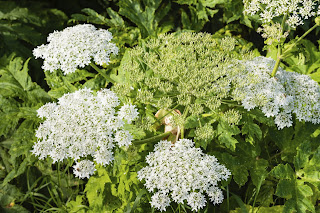
Giant hogweed is a herbaceous plant that belongs to the carrot family (Apiaceae). The Caucasus and Central Asia are the origins of this plant. It was introduced to Britain as an ornamental plant in the nineteenth century. It was transferred to the United States a century later, where it “escaped” from gardens and began to invade new ecosystems. This plant prefers moist, rich soil in places with adequate precipitation. It is most commonly seen around streams, marshes, and ditches. Because it spreads swiftly, upsets native animals, and harms human health, giant hogweed is categorized as an unpleasant weed in most European and American countries. The Giant hogweed is illegal to plant in numerous North American states.
Giant hogweed can grow to be 15 to 20 feet tall.
The strong green stem of giant hogweed is coated with purple streaks and white hairs.
Giant hogweed has lobed and serrated margins on its thick green leaves. They have a diameter of up to 5 feet.
White hairs cover the stems of the leaves.
Giant hogweed bears white flowers in an umbel-shaped terminal inflorescence. The diameter of the flower head can reach 2.5 feet.
Once in a lifetime, giant hogweed blooms. From spring till mid-summer, flowers can be seen.
100 000 winged, oval seeds are produced by giant hogweed. Seed distribution is aided by animals, rain, and wind. Even after ten years of dormancy, seed can germinate.
Furanocoumarins are poisonous compounds found in sap collected from the leaves, stem, root, flowers, and seed.
Phytophotodermatitis is a significant reaction that these chemicals cause on human skin (light-induced skin irritation). Plant sap disables natural defense systems that shield skin from the sun’s harmful effects (more precisely of the UV rays). As a result, the skin develops huge burns and blisters.
Dermatitis manifests itself 1 to 3 days following exposure with sap. Large, black blisters appear 48 hours later on average. After a few days, they transform into brown scars. Scars can last anywhere from a few months to six years on the skin. After coming into contact with giant hogweed, your skin will be sun sensitive for years.
To avoid a major response, quickly cleanse the skin with water after coming into touch with giant hogweed. In addition, the affected person should avoid sun exposure.
When the sap of giant hogweed comes into contact with the eyes, it causes temporary or permanent blindness.
People used to plant this plant as a bee food source before they realized it was dangerous.
Due to its huge size and power, the plant is technically known as “Heracleum.” Hercules, the Greek hero, was described in the same way.
Iranian cuisine uses the dried seed of giant hogweed as a spice.
In 1971, the rock band Genesis released the song “The Return of the Giant Hogweed.” The song describes the plant’s detrimental impact and people’s helplessness to eradicate it.
Giant hogweed is a perennial plant that can live in the wild for 5 to 7 years.









